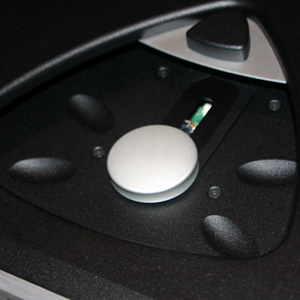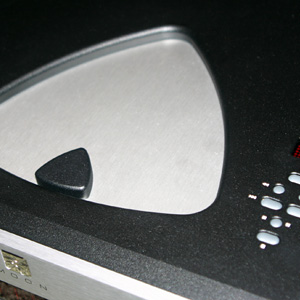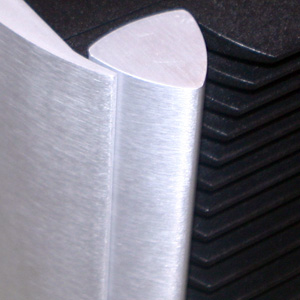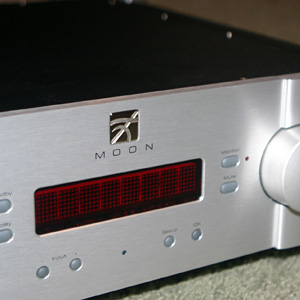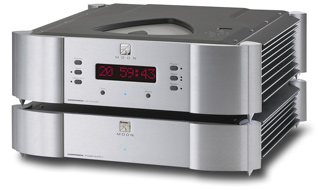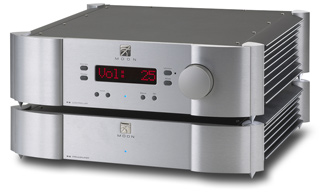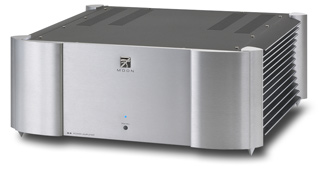 |
|||||||||
| April 15, 2006
It seems I used to upgrade my audio system every other week, but these days I rarely spend any money on equipment. I didn’t buy a single product in 2005, though I did build a new dedicated listening room. Early in 2006 I bought an Esoteric UX-3 universal audio/video player, an upgrade from my Esoteric DV-50, but I don’t foresee buying anything else this year. The reasons for my sabbatical from upgrades are these: First, I now have a carefully assembled system comprising electronics from Boulder Amplifiers and speakers from Wilson Audio Specialties. I’ve been extremely happy with this combination, and I don’t see that changing. Second, there just isn’t that much that I audition that I feel compelled to shell out money for. What does all that have to do with Simaudio’s Moon Evolution Series Andromeda CD player ($11,500 USD), P-8 preamplifier ($11,000), and W-8 power amplifier ($10,500)? If I were in the market for a new system, I’d buy them all in a heartbeat. They hit all of my hot buttons. They’re that good. Evolution The Simaudio Moon Evolution series encompasses eight components: two CD players, two preamplifiers, three power amplifiers, and an integrated amplifier. The Evolutions share a few important design traits: each is fully balanced and dual-mono; RS-232 ports are standard for accommodating future upgrades and compatibility with Crestron and AMX; there are balanced XLR and single-ended RCA inputs and outputs on very-high-quality connectors; screw-on cone footers and cup-type bases come with each chassis; all chassis are identical in width (18.75") and depth (16.5"); and each unit’s appearance can be customized through Simaudio’s C4 system. The last gives the owner, at time of purchase, the option of choosing 24 cosmetic combinations: essentially, the bolt-on aluminum outer parts can be changed to alter the appearance of the components, all of which are available in silver or black brushed aluminum. The W-8 stereo amplifier (18.75"W x 7.5"H x 16.5"D) is rated to deliver 250W into 8 ohms, 500W into 4 ohms, or 1000W into 2 ohms, with the first 5W of output power in class-A. At least according to Simaudio’s specifications, the W-8 appears to be a powerhouse of an amplifier. It weighs almost 90 pounds, largely due to the dual 1.3kVA transformers and eight soda-can-sized filter capacitors totaling 240,000µF -- a seriously stout power supply that would more than support the prodigious output power rating. Simaudio says the W-8 will supply 64 amperes of peak current. Do you have hard-to-drive speakers? Not hard for this amp. Throwing heavy iron into an amplifier makes sense, but the circuit design is what ultimately determines how the thing will sound. To that end, Simaudio developed its Lynx circuitry for the Evolution line. Although I couldn’t determine all that Lynx encompasses, from what I gather, the heart of it is a no-overall-feedback design that results in "virtually nonexistent intermodulation distortion and the elimination of common phase errors resulting from feedback." From talking with Simaudio’s marketing maven, Lionel Goodfield, at the 2006 Consumer Electronics Show, I gathered that this supposedly culminates in sound that is devoid of solid-state nasties; in other words, it avoids the type of sound that drives many to tubes. The P-8 preamplifier is a two-box affair. Its audio circuitry is in the smaller case (18.75"W x 4"H x 16.5"D), and the LED display and power supply, control, and software functions are in the larger (18.75"W x 5.5"H x 16.5"D). The P-8’s volume adjusts with a large knob on the right-hand side of its clean, attractive faceplate. The front-panel controls also include Mute, Display (for brightness adjustment), Input, Setup, and Standby -- all small, centrally located buttons. Circuitry highlights abound: According to Simaudio, the volume-control design is "based on the R-2R resistor array configuration that uses metal-film surface-mount resistors with 0.1% tolerances, resulting in no sonic degradation of the audio signal regardless of the selected volume setting." The power supply is impressively robust, as in the W-8 power amp: The P-8 sports an "oversized dual-mono power supply [that] features six stages of DC voltage regulation and choke filtering." One feature of the P-8 I absolutely loved was that volume control, which has 530 individual steps available. At the low end of the range the steps are in coarser 1dB steps, but once you get to the middle of the range -- where most of my listening took place -- each increment is only 0.1dB. This makes dialing in that absolutely perfect volume setting a snap. I’ve not seen a more user-friendly volume scheme anywhere. The remote control is a large, chunky wand that also controls the other components in the Evolution series. The Andromeda CD player is another pair of boxes chock full of goodies. The main unit is the player itself (18.75"W x 5.5"H x 16.5"D), a top-loader featuring 24-bit/705.6kHz upsampling Burr-Brown DF1704 digital filters and B-B’s PCM1704U-K DACs. There is a digital input so that you can use all of this horsepower with any external source that has a digital output. The Andromeda’s transport mechanism is the Philips CD-Pro 2M, a well-regarded workhorse that anchors numerous top-end players from other companies as well. Simaudio says that the Philips transport is mounted on a "gel-based Delta suspension," which I assume isolates it from error-inducing vibration. The disc, once placed in the transport, is locked in with a large, circular magnetic clamp whose underside is fitted with a sticky rubber compound. Be careful when removing the clamp from a disc -- it sticks like a tick on a dog’s ear. The Andromeda’s power supply is housed in a separate, smaller box (18.75"W x 4"H x 16.5"D). Power-supply voltage regulation (56 stages) includes i2DCf (Independent Inductive DC Filtering): One inductor is dedicated to each integrated circuit-type component (DAC, op amp, etc.) in the audio circuit’s signal path. (The P-8 also employs i2DCf.) Going through all the design features of the Andromeda would take up my allotted space for this article; you can find all the pertinent details on the Simaudio website. Another feature I absolutely swooned over is the top-mounted controls. Makes sense for a top-loading player, eh? Simaudio has gone to great lengths to ensure that each Evolution component matches its siblings in appearance, function, and ergonomics. The SimLink connection itself is worth studying. A small SimLink mini-plug cable lets the Evolution components "talk" to each other. This feature syncs functions such as the brightness level of the displays and the standby function (putting one Evolution component in standby puts them all in standby). Pressing Play on the Andromeda CD player also prompts the P-8 preamplifier to revert to the correct input to play a CD. These may seem inconsequential functions, but they make daily use of an Evolution system that much more pleasant.
Setup, review system, methodology There were two approaches I could have taken in reviewing the Simaudio Moon Evolution system. First, I could have inserted each component into my system individually and noted the changes each made to the sound of my reference system. There’s some validity to this approach, of course, and it’s exactly what I do with each review of an individual component. The downside is that you miss the initial synergy, if any, that you’d hear with the components -- which were designed to be used as a system -- working together. So because this review is of a system of components, I used that as a starting point for my audition. Instead of piecing the system together one component at a time, I simply removed my reference electronics (Esoteric UX-3 universal audio/video player, Boulder Amplifiers 1010 preamp and 1060 power amp; system price $41,250) and inserted all three Simaudios into my rig. I wanted my first observations to be of the components working in their most ideal environment, in an immediate contrast with what they’d replaced. The Simaudio Evolutions drove two different speaker systems while at my residence: first, the Wilson Audio Alexandria X-2s; and second, the subject of April 1’s equipment review, the Silverline Audio Grandeur Mk.IIs. Cabling remained the same throughout the review: Shunyata Research Antares XLR interconnects and Orion speaker cables. I plugged the Andromeda CD player and P-8 preamplifier into a Shunyata Model-8 power conditioner. The W-8 had its own dedicated 20A line. Sound The changes wrought by inserting the Simaudio Moon Evolution electronics into my system were at once obvious and enticing. Two unmistakable characteristics defined what I heard: one had to do with soundstaging, the other tonality. Both would have been immediately identifiable to even casual listeners -- even some of the iPod crowd. (OK, I’m part of the iPod crowd, too.) From the opening note, I heard a greatly expanded soundstage: Height, depth, and image size were all increased over those presented by my reference Boulder-Esoteric setup. In fact, the soundstage was so large that, with many of the CDs I played, I felt I needed to look to the left, then back to the right, then left again in order to "see" all the players. I was amazed at the breadth of it all. It made many of the discs I played simply more thrilling. However, my reference electronics cut a more well-defined soundstage than the Simaudio system, with laser-etched images and definition to spare. I suspect many listeners would prefer the Simaudios’ grander scale. My preferences would likely depend on the speaker system I was using. With the Silverline Grandeur Mk.IIs, for instance, the Boulder-Esoteric components helped persuade the speakers to sound more precise, less plummy in the midbass (the Silverlines tended to be warmer and rounder in the bass and midbass than what I’m used to). With my Wilson Alexandria X-2s, however, the Boulder-Esoteric system tended to reinforce exactly the same strengths that the Wilsons exhibit so mightily themselves: precision and focus. That combination can almost overwhelm in its microscopic resolution. The Simaudios complemented the Wilsons in some of the same ways I’d imagine a great set of tube components would; that is, by adding scale and body. The Simaudios retained the Wilsons’ inherent strengths, but displayed them on a bigger, more expansive soundstage.
I can’t put it any plainer: If you like a huge soundstage, listen to this system of Evolution electronics. As I played cut after cut from audiophile favorites such as Holly Cole and Diana Krall to Enya and Fourplay, my room was awash in big, present sound that largely disintegrated the wall boundaries. This was true with both the Wilson and the Silverline speakers. Once I’d recovered from my awe at the Evolutions’ magnificent soundstage, I focused on their tonal qualities. That’s when I noted the second significant attribute the Simaudios brought to my table. It took only a few discs and a short listening session to realize that the Simaudios were warmer and more fleshed out than what I was used to. There was a glowing warmth to male vocals, such as those on "Home," from Michael Bublé’s It’s Time [Reprise 48946]; and instrumental tracks such as "Max-O-Man," from The Best of Fourplay [Warner Bros. 46661-2]. The warmth I heard didn’t sound like coloration per se, but an organic richness that fully illuminated whatever music was on the discs I was playing. I was quite comfortable with this sound -- there was none of the nagging feeling of discontent I get when listening to fatiguing electronics. Fatiguing the Simaudios were not. That warmish tone didn’t overlay the music in a negative way; there was no veiling of Bruce Cockburn’s raspy voice or smooth guitar on "Mango," from Breakfast in New Orleans, Dinner in Timbuktu [Rykodisc 10407]. Whatever was captured on the discs I know so well was what I heard during playback. While I can’t say the sound was more accurate than what I hear with my reference electronics, I didn’t feel it was less accurate, either. I don’t want to understate this point: Listening to both the Simaudio system and the Boulder-Esoteric ensemble reminded me that I was traversing some mighty lofty terrain. Both systems were just fantastic, with only mild differences separating their tonal profiles. Bass was as you’d expect from a large, solid-state amplifier: forceful and deep, with plenty of drive. Bach’s Toccata and Fugue in D Minor, as performed by Ales Barta on SACD [Organ Surround Illusion, Exton OVGY-00001], was room-filling and delivered with sustained drive and energy. This meant that the W-8 power amplifier had plenty of guts. I got that signature bass that comes with the best brute amps I’ve heard from the likes of Krell or Gryphon. But the Simaudios were not only brutes. At the other end of the spectrum, the high frequencies were extended and airy, without hash or grain. The finely textured cymbal work on Bernier’s "Poinciana," from A Sound Impression [van den Hul VDH99CR05], was sweet and free of grain -- again, what you should expect from a first-class set of modern electronics. The frequency extremes held no surprises. That’s a good thing. I tried various combinations of the individual Simaudio components with pieces of my Boulder-Esoteric reference system and could not find a bad match in the bunch. However, each system worked best with its partnered electronics. The Simaudio Moon Evolution Andromeda, P-8, and W-8 sounded best when used together, period. I guess there’s no surprise there, either. Conclusions I could make the Simaudio Moon Evolution components my desert-island electronics. They complement music. Buy them and use them as a system and you’ll get all the magic they’re capable of. Couple that majestic sound with the good looks and ergonomic delight that these products bring to the dance, and you might just attain that elusive audiophile goal: a last purchase. ...Jeff Fritz Manufacturer contact information: Simaudio USA E-mail: info@simaudio.com
Ultra Audio is part of the SoundStage! Network. |

